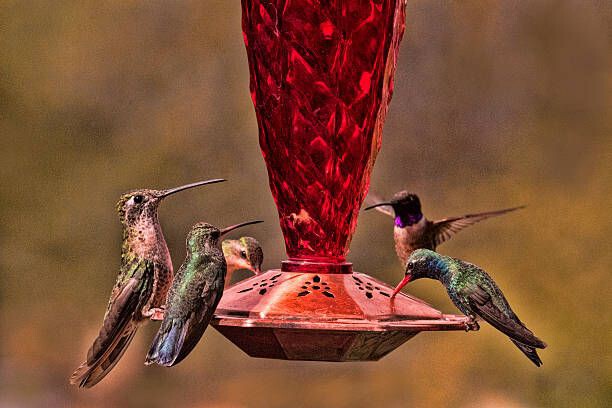These tips will bring hummingbirds to your garden all season long.
Hummingbirds are stunning creatures! Intent on their business, these winged jewels sometimes zip by you close enough to hear the whir of their tiny wings. With their super-fast metabolisms, they must eat several times their weight every day, sipping nectar every 10 to 15 minutes. It’s estimated they visit from 1,000 to 2,000 flowers a day! Hummingbirds are drawn to flowers by color, rather than scent, according to the National Audubon Society. They prefer flowers that are red, orange and pink, though they’ll sip from many different colors. You’ll have a better chance of attracting these teeny wonders if you plant some of their favorite flowers and provide cover for them to perch and nest.
Here's what you need to attract hummingbirds to your garden:

Hang up a feeder (or two!).
Feeders provide another food source in addition to flowers. Look for one that’s easy to take apart because you’ll need to clean it every few days to prevent bacteria and mold from growing, which can be fatal to hummingbirds. Make nectar combining 1 cup of water and ¼ cup of white sugar, brought to a boil, then cooled. Don’t use red dye, brown sugar, honey, molasses, or syrup, which are not safe for hummingbirds. If possible, place your feeder in a shaded area so the sugar syrup doesn't go bad too fast. Wash the feeder every few days or when it gets cloudy with a solution of one part white vinegar and four parts water. Rinse with warm water three times to remove all residue before refilling.
Because hummingbirds are territorial, it’s also best to place several feeders throughout your garden. Avoid using feeders with yellow bee guards because they actually may draw bees, and add an ant moat to prevent them from swarming your feeder. Hummingbirds won't come if ants are clogging up the feeders. Remove feeders in the fall about two weeks after you see the last hummingbird.
Plant flowers they love.
It's often easier for hummingbirds to spot your feeder if you catch their attention first with flowers they love. Plant a combination of annuals, perennials (which come back every year), and shrubs so they'll have a variety of options. Make sure the perennials and shrubs you choose will survive winters in your USDA Hardiness zone (find yours here).
Different bloom times also guarantee your hummingbirds will have food sources all season long. Some favorite annuals include torenia, fuchsia, and cuphea. They also love perennials such as columbine, bee balm, catmint, and salvia and shrubs such as butterfly bush and Rose of Sharon.
Give them a place to splash.
Hummingbirds like to rinse off as much as any other bird! They sometimes bathe in pools of droplets on leaves or morning dew. Provide a water source for them with a drip fountain or a fine sprinkler; they don't use bird baths but will fly through a misting device (some are solar-activated, so you can float them on top of your birdbath). Change the water daily.
Make your yard hummingbird-friendly.
Despite their speedy zipping about, hummingbirds do rest occasionally! They like to sit and survey their domain, so leave a few exposed dead sticks and small branches on shrubs and trees in your garden so they have a protected place to perch. Males especially like to watch and defend favorite flowers or feeders! They also eat insects, so plant trees such as oaks, birches, and willows, which host many caterpillars that hummingbirds adore.